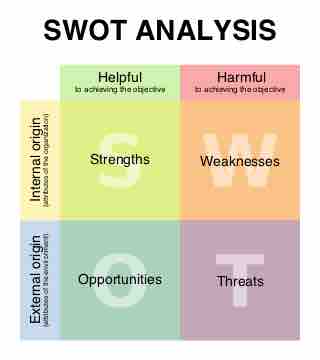Effectiveness is the capability to produce a desired result. Strategy is considered effective when short-term and long-term objectives are accomplished and are in line with the mission, vision, and stakeholder expectations. This requires upper management to recognize how each organizational component combines to create a competitive operational process.
Suitability, Feasibility, and Acceptability
With the above framework in mind, a number of academics have proposed perspectives on strategic effectiveness. Johnson, Scholes, and Whittington suggest evaluating the potential success of a strategy based on three criteria:
- Suitability deals with the overall rationale of the strategy. One method of assessing suitability is using a strength, weakness, opportunity, and threat (SWOT) analysis. A suitable strategy fits the organization's mission, reflects the organization's capabilities, and captures opportunities in the external environment while avoiding threats. A suitable strategy should derive competitive advantage(s).
- Feasibility is concerned with whether or not the organization has the resources required to implement the strategy (such as capital, people, time, market access, and expertise). One method of analyzing feasibility is to conduct a break-even analysis, which identifies if there are inputs to generate outputs and consumer demand to cover the costs involved.
- Acceptability is concerned with the expectations of stakeholders (such as shareholders, employees, and customers) and any expected financial and non-financial outcomes. It is important for stakeholders to accept the strategy based on the risk (such as the probability of consequences) and the potential returns (such as benefits to stakeholders). Employees are particularly likely to have concerns about non-financial issues such as working conditions and outsourcing. One method of assessing acceptability is through a what-if analysis, identifying best and worst case scenarios.

SWOT Analysis
Here is an example of the SWOT analysis matrix.
Mulcaster's Managing Forces Framework
Will Mulcaster argued that while research has been devoted to generating alternative strategies, not enough attention has been paid to the conditions that influence the effectiveness of strategies and strategic decision-making. For instance, it can be seen in retrospect that the financial crisis of 2008 and 2009 could have been avoided if banks had paid more attention to the risky nature of their investments. However, knowing in hindsight cannot address how banks should change the ways they make future decisions.
Mulcaster's Managing Forces Framework addresses this issue by identifying 11 forces that should be taken into account when making strategic decisions and implementing strategies:
- Time
- Opposing forces
- Politics
- Perception
- Holistic effects
- Adding value
- Incentives
- Learning capabilities
- Opportunity cost
- Risk
- Style
While this is quite a bit to consider, the key is to be as circumspect as possible when analyzing a given strategy. In many ways it is similar to the potential issues a scientist faces. A scientist must always be objective and conduct experiments without a bias toward a specific outcome. Scientists don't prove something to be true; they test hypotheses. Similarly, strategists must not create a strategy to get to an end point; they must instead create a series of likely endpoints based on organizational inputs and operational approaches. Uncertainty is key, allowing strategic improvement for higher efficacy.
Example
A firm may perform a break-even analysis to determine if a strategy is feasible. The break-even point (BEP) is the point at which costs or expenses and revenue are equal: there is no net loss or gain, so the company has "broken even." For example, if a business sells fewer than 200 tables each month, it will make a loss; if it sells more, it will make a profit. With this information, managers could determine if they expected to be able to make and sell 200 tables per month and then implement a strategy that is in accordance with their projections.